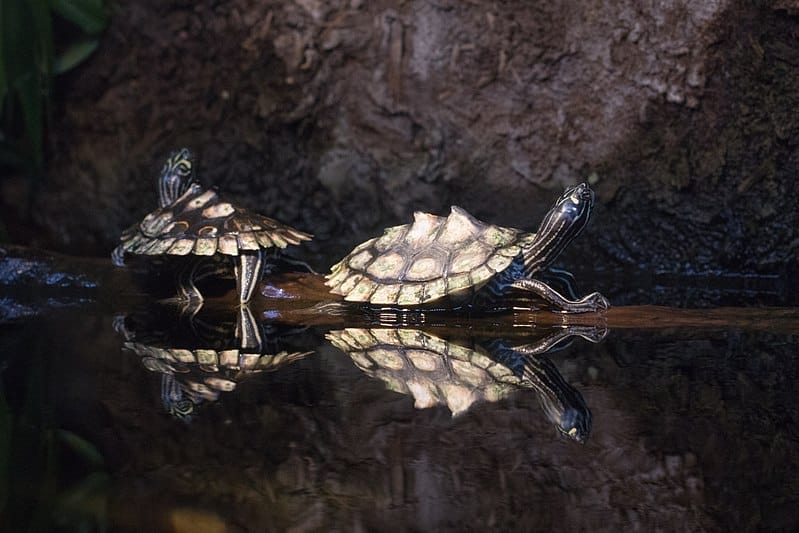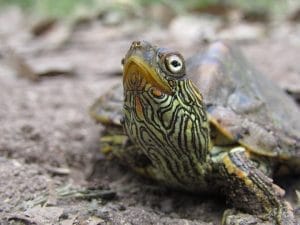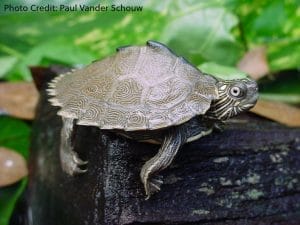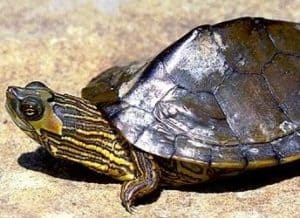Graptemys oculifera (Ringed Map Turtle)
Home > Turtle Database > Graptemys oculifera (Ringed Map Turtle)
The Ringed Map Turtle (Graptemys oculifera) is a small, freshwater turtle known for its distinctive concentric rings on the carapace. Endemic to the Pearl River system in Mississippi and Louisiana, this species is notable for its limited geographic range and specialized habitat requirements.
Native Turtle Species Map – Find Turtles by Region
Scientific Classification
- Kingdom: Animalia
- Phylum: Chordata
- Class: Reptilia
- Order: Testudines
- Family: Emydidae
- Genus: Graptemys
- Species: Graptemys oculifera
Common Names
- Ringed Map Turtle
- Ringed Sawback Turtle
This Hilarious Turtle Book Might Know Your Pet Better Than You Do
Let’s be real—most turtle care guides feel like reading a textbook written by a sleep-deprived zookeeper.
This one’s not that.
Told from the snarky point of view of a grumpy, judgmental turtle, 21 Turtle Truths You’ll Never Read in a Care Guide is packed with sarcasm, sass, and surprisingly useful insights.
And hey—you don’t have to commit to the whole thing just yet.
Grab 2 free truths from the ebook and get a taste of what your turtle really thinks about your setup, your food choices, and that weird plastic palm tree.
It’s funny, it’s honest, and if you’ve ever owned a turtle who glares at you like you’re the problem—you’ll feel seen.
Identification
Description
The Ringed Map Turtle has an olive to brown carapace adorned with yellow to orange concentric rings on each scute, giving it a striking appearance. Adults typically measure between 3.5 to 7 inches (9 to 18 cm) in carapace length. The plastron is pale yellow, and the skin features yellow stripes against a dark background. A notable characteristic is the large yellow spot located behind each eye.
Sexual Dimorphism
Females are significantly larger than males, often reaching up to 7 inches in carapace length, while males seldom exceed 4 inches (10 cm). Males possess longer tails and more elongated foreclaws, which are used during courtship displays.
Check more turtles from the Graptemys genus
Native Origin and Distribution
Geographical Range
This species is endemic to the Pearl River system in Mississippi and Louisiana, USA. Its distribution is confined to approximately 400 miles (640 km) of the river and its tributaries.
Preferred Habitat
The Ringed Map Turtle inhabits large rivers with moderate to strong currents. It prefers areas abundant in basking sites like fallen trees and logs and requires sandy banks for nesting purposes.
Behavior
Feeding Habits
Primarily carnivorous, the Ringed Map Turtle feeds on aquatic insects, mollusks, and crustaceans. Occasionally, it may consume plant matter, especially algae.
Predators
Predators include raccoons, alligators, and large fish. Eggs and hatchlings are particularly vulnerable to predation by birds, mammals, and other reptiles.
Reproduction
Breeding Season
Breeding occurs from late spring to early summer, with nesting typically taking place from May to July.
Reproductive Method
Females lay clutches of 3 to 7 eggs in sandy nests dug along riverbanks. The incubation period lasts about 70 to 80 days, with hatchlings emerging in late summer or early fall.
Conservation
Extinction Status
- U.S. Endangered Species Act: Threatened
- IUCN Red List: Vulnerable
Threats
Major threats include habitat degradation due to pollution, river channelization, dam construction, and increased siltation. Human recreational activities can disturb nesting sites, and illegal collection poses additional risks.
Conservation Measures
Efforts focus on habitat protection and restoration, enforcing regulations against illegal collection, and monitoring populations. Public education campaigns aim to raise awareness about the species and promote conservation initiatives.
Economic Importance
While the Ringed Map Turtle has limited direct economic value, it contributes to the biodiversity of the Pearl River system. Its presence can enhance ecotourism opportunities, promoting local economic benefits through nature-based recreation.
Interesting Facts
- It is one of the most geographically restricted turtle species in North America.
- The species’ name “oculifera” means “eye-bearing,” referring to the eye-like rings on its shell.
- Due to its specialized habitat needs, the Ringed Map Turtle serves as an indicator species for the health of the Pearl River ecosystem.

About Author
Muntaseer Rahman started keeping pet turtles back in 2013. He also owns the largest Turtle & Tortoise Facebook community in Bangladesh. These days he is mostly active on Facebook.















